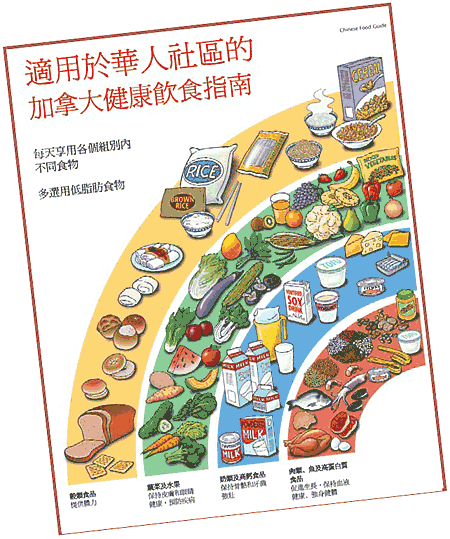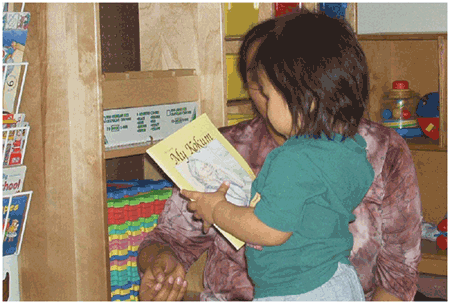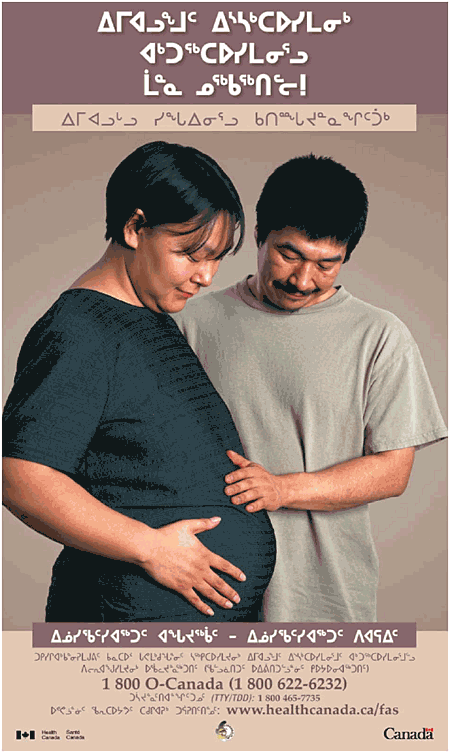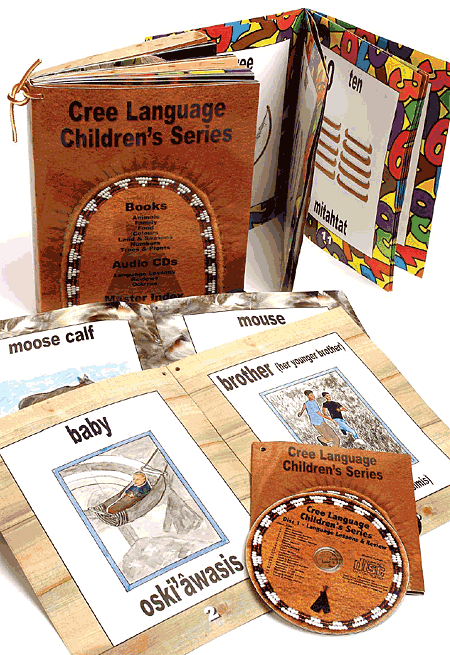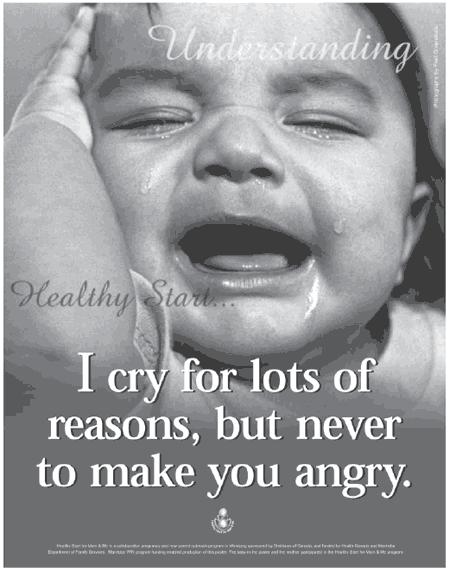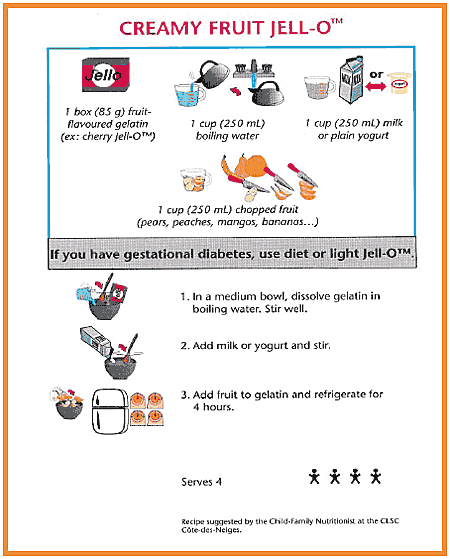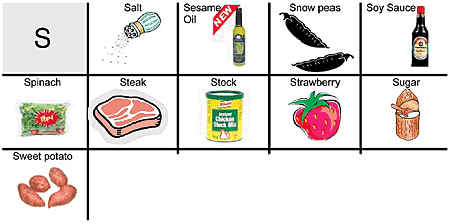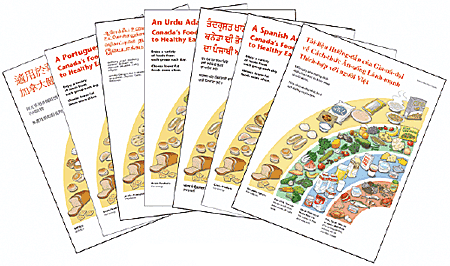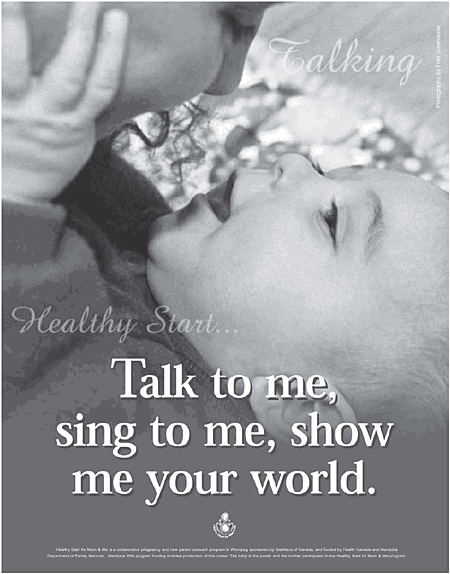Common menu bar links
Institutional links
Diseases & Conditions
Health & Safety
Research & Statistics
Agency Information
Search Box
E-mail this page
Language, Literacy and Healthy Development: The Work of CAPC and CPNP Projects
Language and culture are inseparable. Programming must reflect what is appropriate for diverse participants. Of particular concern are projects that serve First Nations and New Canadians. In the Literacy Matters survey projects shared how they take a linguistically and culturally responsive approach when they:
- Communicate in the first languages of new Canadians
- Provide written materials in multiple languages
- Honour First Nations and Inuit languages and traditions
Communicating in First Languages of New Canadians
Sometimes newcomers to Canada speak little or no English. CAPC and CPNP projects have designed numerous strategies to reach and teach them.
First contact in first language
Many projects select personnel from the community who understand both the language and the local cultural context. In the words of one project that serves new Canadians: It is important to have staff and/or volunteers able to speak their language and aware of the culture, traditions, and strengths/challenges they bring from their homeland (Kathy Simpson, Simcoe County & York Region CAPC).
|
Staff helps bridge the linguistic and cultural gap that new Canadian families experience, assisting in the process of social integration. As Lorraine Makus of Anna's House puts it:
- Having staff that speak their language also is very helpful (otherwise we probably wouldn't be seeing as many of these families). Very often they need someone to talk to and to share their experiences with.
Home-visiting programs are effective because they offer ongoing personal contact in the participant's first language. In some projects, bilingual and multilingual home visitors are available to disseminate health and parenting information in the family's first language. Home visitors are particularly important for immigrant women who speak neither English nor French:
- It is a lot more difficult for women to learn the language than for their partners, and it is often difficult for the women to come out to programs due to time pressures at home and transportation difficulties (Lorraine Makus, Anna's House).
|
Interpretation for ESL participants
Interpreters play a vital role for some families to access health information and health services. However, for some linguistic groups they can be difficult to find, hard to access, and expensive.
|
In some locations it is virtually impossible to find professional interpreters in the participant's first language, so project personnel are resourceful. In addition to using staff and community members as interpreters, they encourage participants to bring family members to appointments for interpretation [and] design flexible schedules for appointments that allow family to attend for interpretation (Diane Hill, Better Beginnings).
|
Print materials in multiple languages
Although accessing print materials for the many linguistic communities served by CPNP and CAPC projects can be challenging, some materials are available in multiple languages:
- We provide a range of print and multimedia material for ESL families. Primary sources include the Talking with Your Child in First Language program and our local Health Unit. (Kathy Simpson, Simcoe County & York Region CAPC)
- We provide the Canada Food guide in eight different languages(Yvette Nechvatal-Drew, Pre & Post Natal Nutrition Project)
- We promote dual language literacy kits through toy lending library (Wendy Pol, Families First in White Oaks CAPC)
|
However, many projects note that publications in the first languages of their participants can be hard to find and expensive:
- We have received some written materials and videos (in low-German) from the Mennonite Central Committee in Aylmer, Ontario. It has been very difficult to access resources from Canada (Lorraine Makus, Anna's House )
- Problem is that not many books are available in different languages, and we have many different languages, more than eight (Candace Wilson, Better Beginnings Now - CAPC)
- Dual language books such as "The Hungry Caterpillar" are often difficult to find in many languages, expensive (Wendy Pol, Families First in White Oaks CAPC)
- Not all material is available in the necessary languages (Cheryl Booth, Port Cares: CAPC Niagara Brighter Futures)
Translation as one solution
Some projects translate written materials from English to the first languages of their participants. That requires human and financial resources. Projects meet the need in various ways:
- Staff provide translations (Candace Wilson, Better Beginnings Now - CAPC)
- We try to utilize staff and volunteers for translation when needed and available (Yvette Nechvatal-Drew, Pre & Post Natal Nutrition Project)
- Some material is translated. However, time is a problem (Cheryl Booth, Port Cares: CAPC Niagara Brighter Futures)
- We are advocating to have materials translated into a variety of different languages, by volunteers who could work out of their home (Project name withheld by request)
|
An Urdu Adaptation of Canada's Food Guide to Healthy
Eating
For People Four Years and Over
|
Limitations of translation
Translation can offer access to information where there was previously none. However, as the saying goes 'something is always lost in the translation.' Helene Osborne comments that "even perfectly exact translations may not make sense to people. Their background or culture may give them a different frame of reference than the one you are using, creating imposing barriers to understanding" (Osborne, Helen. In Other Words. . . It Takes More Than Just Words; Culturally and Linguistically Appropriate Materials. On Call April 2000. <www.healthliteracy.com/oncallapr2000.html>).
Honouring First Nations and Inuit languages and traditions
Context
First Nations and Inuit languages and cultural traditions are central to the work of many CAPC and CPNP projects. The challenges of preserving traditions and values in a rapidly changing society are complex, and diverse for First Nations and Inuit participants. Consequently project staff must strive to be sensitive to the needs of individual participants within the context of their social and cultural history. Kelly Lemoine, of Healthy Moms, Healthy Babies speaks of the complexity in this way: Strengths and needs are directly related to cultural traditions and values but have also been affected by today's society. I have found that it is very important to consider past family history and family dynamics when working with these participants.
|
Commenting on the way in which cultural teachings and traditions are valued in present child-rearing practices, Connie Epp noted that, Cultural teachings and traditional parenting skills are very important to the participants (Healthy Moms, Healthy Babies). These traditional ways are incorporated in the approach and materials of some projects. However, in others - particularly those serving Aboriginal people off-reserve - staff observe that participants have lost touch with traditional teachings, which raises the question of how Aboriginal traditions should be treated. Stories offer one time-honoured way in which Inuit and First Nations people preserve and transmit their cultural traditions; they have been a cultural art form used for generations as a teaching device. Projects observe:
- Families often have a thirst for knowledge about stories to tell their children (Marg Mitchell, Otenwa Iyniuk/Ben Calf Robe Society)
- We use traditional Aboriginal songs and tales, and we invite our Elder in to share a story with the children (Barb Desjardins, In A Good Way)
- Storytelling by elders is very popular (Connie Epp, Healthy Moms, Healthy Babies)
Increasingly, these stories and legends are being told in children's picture books, many of them illustrated by Aboriginal artists using both traditional and contemporary visual art forms. While such picture books can be enjoyed by everyone, they are especially helpful for beginning readers, making the vital connection between oral, visual, and print literacies. Lynda Doige of the Mi'kmaq-Maliseet Institute at the University of New Brunswick has compiled an extensive booklist. She can be contacted at ladoige@unb.ca
|
The preservation of First Nations languages has been the subject of much discussion. In an article entitled Exploring Northwest Territories Literacies, Helen Balanoff comments that "the health of the Aboriginal languages varies widely, but most are declining. The language shift is clear on the chart [below] which shows the number of people whose mother tongue is an Aboriginal language compared to those who use their Aboriginal language in their home."
| Aboriginal Language Shift | ||||||
|
Inukitut*
|
Slavey
|
Dogrib
|
Chipewyan
|
Gwich'in
|
Cree
|
|
| Mother Tongue |
835
|
2075
|
2000
|
515
|
250
|
185
|
| Home Language |
160
|
1190
|
1355
|
210
|
40
|
30
|
| Change Index |
-80.90%
|
-42.70%
|
-32.30%
|
-59.20%
|
-84.00%
|
-83.80%
|
|
* Includes Inuvialuktun and Inuinnaqtm |
||||||
In spite of this language shift, says Balanoff, "literacy models and practices of many families and communities still reflect those of Aboriginal language and culture: their purposes for using literacy; their ways of supporting children's literacy development; their attitudes towards literacy and the role that family members play in literacy development." To facilitate a better understanding of these literacy practices among people involved in literacy development, The Northwest Territories Literacy Council, in partnership with an Aboriginal language community, is presently seeking funding to research traditional and present-day home and community literacies (Balanoff, Helen. Exploring Northwest Territories Literacies. Literacies #1, Spring 2003. <www.literacyjournal.ca>).
|
Print Materials in Inuit and First Nations languages
Print materials can obviously make a significant difference in the preservation of language and culture. When people have access to books in their first language they have a head start on learning to read because there is a clear connection between what is understood and spoken, and the printed words that represent these ideas.
|
Some projects report difficulty in accessing print materials in First Nations languages. First Nations linguistic communities are small enough that publishing is not an economically viable proposition for commercial publishers. This means that such resources are extremely limited. As one project comments: Pemmican Press seems to be our only relevant publisher; we have difficulty in obtaining any materials that celebrate cultural diversity. (Lorise Cablik, Futures Program).
This is a serious problem for Inuit and First Nations trying to promote authentic literacies that reflect their traditions and cultures. To some extent, the government is helping fill this void. One project noted that the First Nations Inuit Health Branch has some interesting materials that focus strictly on Aboriginals. They contain simple text and lots of pictures. The order form for these materials can be found at: <http://www.hc-sc.gc.ca/fnihb-dgspni/fnihb/bpm/prc/pc_orderform.htm>
|
|
|
Cultivating healthy communities
Accessing health, social, and educational services is a complicated and politically charged process. At a practical level there are bureaucratic procedures and legalistic forms to negotiate. The sheer amount of paper is forbidding, and fine print can be intimidating to those who read poorly. There are many factors that can impact on the facility to read, especially when literacy is already an issue. For instance, family and personal crisis can diminish a person's ability to cope with written material. Furthermore, pride may stand in the way of admitting confusion about technical words or jargon. And new parents, new immigrants or those who have been rendered homeless may all be unfamiliar with the range of services available and uninformed about how to access them. Whatever the reason, some parents and prospective parents require literacy support to:
- Access information
- Claim their rights
- Take advantage of services to which they and their children are entitled
- Comply with laws and regulations
|
Negotiating paperwork to access services
By helping parents negotiate their way through paperwork, CAPC and CPNP staff help parents improve the quality of life for their families. Indeed, help with reading and writing can make a significant difference to sustaining the family unit. Project staff help parents fill out forms, including:
- Rental agreements
- School registrations
- CPNP Welcome forms
- Financial aid applications
- Applications for further education
- Housing applications
- Income tax returns
Advice, advocacy and support
Support may take the form of advice and advocacy. Sometimes just a 'guide by the side' makes a big difference. And whatever task is the primary goal, countless incidental literacy lessons will occur while it is carried out, building confidence and skill with print. Projects report that they:
- Provide volunteers to go grocery shopping with parents who can't speak English
- Advocate on behalf of participants by attending appointments, etc. and help them understand what is being said and/or written (Wendy Trylinski, The Child/Family Resource Center Inc.)
- Accompany many women to their doctors' appointments, housing appointments, financial aid appointments, etc. to advocate and support them (Connie Epp, Healthy Moms, Healthy Babies)
- Cook, shop, deal with health issues, read books, and help with letters that come to residents (Debbie Smith, Buccaneer Bay Outreach Centre)
- Help with school work, income tax, etc. (Debbie Smith, Buccaneer Bay Outreach Centre)
- By taking them through tenant applications, resume building, storytelling, bookmaking, chart/poster design, formal/informal discussions, crafts, theme teaching both orally and as written, we begin to bridge the gap between being able to make sense of our world and approaching it with confidence (Lorise Cablik, Futures Program)
|
Empowerment
There is no single, correct source of information on healthy family living or parenting. Celebrities such as Oprah Winfrey have a powerful voice. So do our own mothers and grandmothers, fathers and forefathers. However, so do the companies who spend millions on advertisements prompting us to eat those very same trans-fat laden foods that Health Canada is cautioning against. And even when we 'listen to the experts' we find that 'the experts' sometimes disagree.
This diversity of ideas is something to celebrate. In a democratic society, everyone is entitled to a voice. But how do we develop a discerning ear, weigh the evidence, and sort out which information is pertinent to us? And how do we find our own voices in this multi-voiced, multi-cultural conversation?
A voice in decision-making
When participants have a voice in the decisions that affect them, staff report these positive effects:
- More control over their lives
- Improved listening skills as well as more confidence to weigh the evidence and speak out accordingly
- Greater understanding of the politics of decision-making
Participants are frequently asked to sit on committees:
- Parents sit on an advisory committee to help with overall planning (Ruth Adamchick, Yellowknife Family Centre)
- Each site in the East Kootenays has their own steering committee to ensure the needs of the communities are being met (parents are also included on these committees), and parents at the groups also give feedback (Cindy Hoffman, East Kootenay Community Action Program for Children)
- Two former participants sit on Steering Committee (one ESL) and both say they learn a lot from it (Gail Wylie, Healthy Start for Mom & Me)
- Parents sit on the Board and Advisory Committees (Wendy Trylinski, The Child/ Family Resource Center Inc.)
- Participants sit on hiring committees (Healthy Start for Mom & Me)
|
Oral and written participant feedback is solicited. Projects report that they:
- Solicit continuous feedback - simple written anonymous comments dropped in a can, or verbal (Gail Wylie, Healthy Start for Mom & Me)
- Maintain content relevance through regular feedback from participants (Michelle Margrait, Maggie's Place - A Resource Centre for Families)
- Hold focus groups periodically to gather information and evaluate the program so that there is opportunity for clients who are less literate to participate and respond/ evaluate the services we offer (Diane Hill, Better Beginnings)
- Adjust content according to discussion direction of the group (Gail Wylie, Healthy Start for Mom & Me)
|
From consumers to critics
When participants move from being mere consumers of information to producers, they begin to sharpen their critical awareness about how pictures and print can be used to shape or inform, divide or unite, control or empower. Many projects involve participants in the empowering process of producing information, including videos, posters and pamphlets. As one project puts it: Our student parents are also active in focus groups for the creation of pamphlets. They were recently chosen to model for the Nobody's Perfect provincial posters. This encourages them to be aware of the important information that can be found in pamphlets and how they can make a difference in making this information current (Lynne Cornish-Braun, Saskatoon Friends of Students and Kids).
Cultivating the confidence to speak out
Participants have a lot to bring to discussions about health and family life since their socio-cultural experiences offer perspectives that are often absent in published literature. Sadly, many participants enter CAPC and CPNP programs with a history of having been silenced, and lacking the confidence to offer their opinions and expertise freely. Program facilitators must work hard to affirm participants' knowledge and perspectives, and provide support for them to find and raise their voices.
Some ways in which participants are encouraged to speak out:
- Provided with opportunities in peer and community groups to share particular health and childrearing concerns
- Invited to share their stories with other participants
- Encouraged to write poetry, stories, and other items for newsletters
Children finding their voices
Much has been written in the child development literature about the importance of oral language development and receptive vocabulary as a foundation for literacy. However, the current emphasis on 'normal' development and standardised testing can obscure the importance of socio-cultural variations in language and literacy. Critical educators and literacy experts are concerned that normative, psychologized definitions of what counts in language, literacy and readiness only serve to silence and marginalize many of the cultures/languages that make up the cultural mosaic of which Canada is so proud. It is particularly damaging to diminish what young children know.
Working from a strengths-based model, CAPC and CPNP projects strive to honour and build on the cultures, languages, and literacies of children as well as their parents. One way to do this is by encouraging children to express their own experience in pictures, gestures and print, whether in Dogrib or low German, English or Cree. This is how children learn that their lives and what they have to say about them matters.
One project cultivates authorship and authority in children by developing books with children to be read by parents. Many of the programs outlined in Section 3 are designed to help children find their voices by:
- Offering opportunities for talking, singing, dancing and dramatizing
- Encouraging children to tell, draw, and write their own stories
- Supporting children to keep records of their experience - collectively and individually
Collective voices
The strength and solidarity of belonging to a group is important, whether the common interest is pregnancy, Fetal Alcohol Syndrome, diabetes, Attention Deficit Hyperactive Disorder, learning to read or raising a family. For one thing, knowing that others have similar experiences is affirming, and speaking out with a collective voice can be a powerful activist tool for effecting social change. To this end, projects report:
- Referring participants to community literacy and health support groups
- Encouraging families to develop networks with each other
|
Supporting everyday needs: Healthy eating
Cooking/community kitchen
- It helps people learn to cook as well as read.
- The community kitchen is community run and the project has access to it (Lynne Cornish-Braun, Saskatoon Friends of Students and Kids)
- Single moms cook a meal and take it home with them. There is usually a literacy related theme or focus in each session. Nutrition is also discussed (Robin Hicken, Gesundheit Für Kinder)
- We host breakfast and have only $25 a week to spend. We believe we need to feed your body before you feed your mind. (Mark Turner, Father Goose, Hilye'yu Lelum (House of Friendship) Society)
- We run a supper club where participants make and eat at the library and take home the leftovers. While the Supper club is running, the library offers homework help for the children of the parents who are cooking. (Cheryl Booth, Port Cares: CAPC Niagara Brighter Futures)
- We use community kitchen for our prenatal group (Lori Lapine, Healthy Babies Right From the Start)
- Many of the teens we serve are single Moms. They are just trying to survive in being a parent. They like attending our community kitchen as it gives them the opportunity to take home finished meals. They like being with other young parents - they learn from each other (Waltraud Grieger, Growing Years Family Resource Centre)
|
Reading recipes
- Participants are shown by example. We're not really concerned with literacy in the kitchen, but find recipes are a wonderful tool for literacy (Mark Turner, Father Goose, Hilye'yu Lelum (House of Friendship) Society)
- Recipes are written at a basic reading level. Our parents are literate enough to comprehend them (Lynn Cornish-Braun, Saskatoon Friends of Students and Kids)
- We use pictorial recipe cards (Cheryl Booth, Port Cares: CAPC Niagara Brighter Futures).
- We use a visual cookbook, The Joy of Life, distributed by the Canadian Prenatal Nutrition Program. The cookbook is simple and easy to use. Kids can use it too (Yvette Nechvatal-Drew, Pre & Post Natal Nutrition Project)
- Recipes are typed in large font. We ensure that selected recipes meet the literacy needs of our clients (Jennifer Sells, Bruce and Grey Brighter Futures)
|
Shopping
- An outside literacy group make volunteers available to go to the grocery store and help people who struggle with reading (Cathy Leclaire, Kids Corp Family Resource Program)
- One thing that really worked well for us was to do a grocery store tour with our immigrant women... imagine going to a grocery store and seeing many unfamiliar foods and not being able to read the labels. Our participants had many questions and we tried to explain some of the more common foods that they might encounter, as well as discussing what good prices were - since they are used to different currencies and prices (Lorraine Makus, Anna's House)
|
|
|
Learning about nutrition
- Nutrition Bingo helps participants learn about the four food groups. I.e. there would be a picture of a biscuit on the bingo card with the name of the object next to it. (Leslie Bernstein, Jewish Family Services of the Baron de Hirsch Institute)
- We also provide gift cards for women to buy fruits & vegetables and milk products. (Anita Harms, Family Education & Support Project of Aylmer)
- Provide healthy snacks, eggs and juice program. (Mary Britten-Belding, VON Healthy Baby and Me (CPNP))
- We have used a First Nations puppet/literature kit we borrowed from Diabetes (B.R.H.A.) Education, for food/nutrition/eating education. (Lorise Cablik, Futures Program)
|
|

